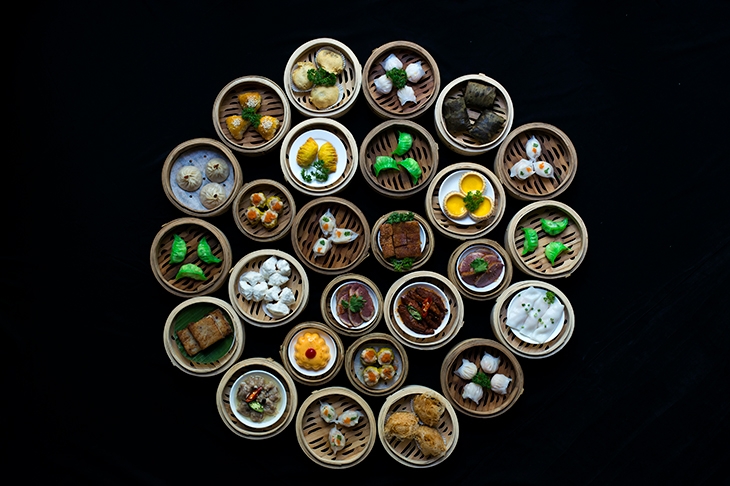A truth that ought to be universally acknowledged is that Chinese food, while much loved, is underappreciated. China certainly has one of the world’s most sophisticated cuisines, yet while there’s a Chinese restaurant in almost every town, there’s little dependable information about it in English aimed at the general reader. Jonathan Clements addresses this in The Emperor’s Feast, a galloping journey through thousands of years of Chinese culinary history, from origin myths through numerous dynasties, the Opium Wars and the Cultural Revolution, right up to the present day. At the start he says his work has been ‘a quest to find out what Chinese food actually is’, by shedding light on its development over time and some of its dizzying geographical diversity.
As Clements rightly points out, the term ‘Chinese food’ can obscure a multitude of local cuisines and cooking processes, as well as a history of constant evolution through cultural exchange:
The stews of the Shang priest-kings were a world away from the banquets of the Tang emperors; and the recipes cooked for the Mongol khans by their Central Asian staff were nothing like the dishes that the people of the Ming era made with new ingredients from across the Pacific.
Meals prepared for the venerated elderly included pheasant soup served with snail juice
He highlights the challenges and controversies of trying to classify regional culinary traditions, noting that the idea that China had four great regional styles dates only to the last dynasty, while the rival notion of ‘eight great cuisines’, so often cited, emerged in a newspaper article in 1980.
A fascinating cast of characters, real and mythological, pepper the pages, including the legendary Divine Farmer Shen Nong, the inventor of the plough; Yi Yin, the chef who became a minister in the Shang dynasty and tutored his king on the finer points of gastronomy; the pork-loving Song dynasty poet Su Dongpo; and Chairman Mao. Clements delves into the origins of many of the traditions that make Chinese food so distinctive, such as qu, the cultured catalysts for fermentation used in making soy sauce and alcoholic drinks, as well as tofu, dim sum, distilled liquors and chillies.
He also gives readers a sense of some of the hot debates that have raged throughout Chinese history on proper ways to eat and drink. Perhaps most importantly, he draws attention to the extreme discernment of elite culinary culture in China from very early times. The ancient Book of Rites, for example, specifies the appropriate fat for cooking each type of meat, and describes meals prepared for the venerated elderly that include pheasant soup, served with snail juice and a vegetable condiment.
Food proves a useful lens through which to view the grand sweep of history. The book traces the emergence of China from a collection of ancient warring states, through dynastic upheavals and foreign conquests. A potentially murderous banquet helps to determine the foundation of the Han dynasty in 206 BC. We visit the Tang dynasty capital of Chang’an (today’s Xi’an), where the emperor’s consort famously demanded lychees couriered from the south; the humming night markets of Song-dynasty Kaifeng; and a Mongol feast at which a controversy over halal meat led to a long campaign against China’s Muslims and their dietary laws.
In more recent times, we hear about the surreal political campaigns and devastating famine of the Maoist era, and the ‘banquet diplomacy’ of the early 1970s, when Zhou Enlai stuffed Richard Nixon and Henry Kissinger with Peking duck during their negotiations. Clements marshals his sources in a deft and approachable manner, leavening the complexities of history with folklore, and spicing up his narrative with piquant anecdotes.
The book is billed as ‘a history of China in 12 meals’, but the food itself is less centre stage than one might expect. Tantalisingly, Clements mentions that his research involved adventures such as roasting wild pigeons in the desert, drinking liquor straight from the still in Shaoxing and visiting a traditional soy sauce factory in Xiamen — but we don’t hear any of the details. Instead, the chapters are structured around different historical periods. We are given mouthwatering glimpses of foods prized in ancient China, such as the lists of seasonal delicacies in the Book of Rites which include a recipe for ‘the Bake’, a three-day extravaganza involving a young pig stuffed with fruit. Otherwise, the emphasis is on the evolution of Chinese eating and drinking customs and cultural exchange rather than actual cooking.
Recent decades have seen a growing international appreciation of the regional diversity of Chinese food. But while China’s rising wealth and power seem likely to elevate its status abroad from the realm of cheap takeaway fare to a more appropriate level, Chinese restaurants have been hard hit by a wave of prejudice triggered by the Covid pandemic. The Emperor’s Feast, by shining a light on some of the intricacies of Chinese history over more than two millennia, serves as a timely reminder that the country’s modern cuisine is the delicious fruit of a rich, ancient and perhaps surprisingly multicultural tradition.






Comments